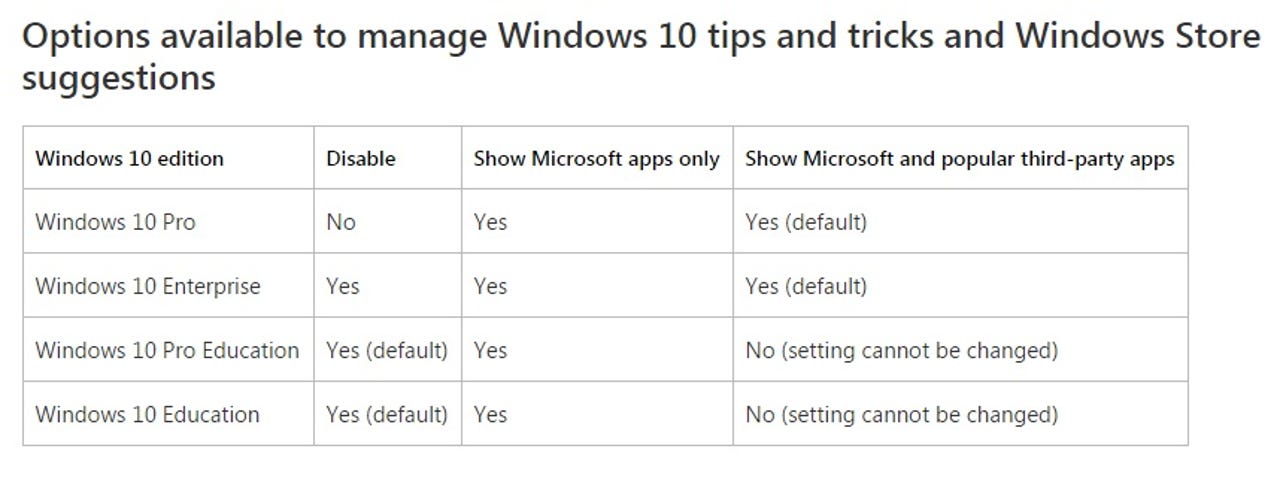Administrators can no longer shut off certain apps, content with Windows 10 Pro Anniversary Update

Last week, when Microsoft quietly introduced a new version of Windows 10 -- Windows 10 Pro Education -- the company also acknowledged it planned to curtail the ability for administrators to manage certain Microsoft and third-party apps.
Microsoft acknowledged the change in a rather confusing July 27 TechNet post, titled "Manage Windows 10 and Windows Store tips, tricks, and suggestions."
That TechNet article includes this chart:

In the TechNet article, Microsoft notes that administrators will no longer be able to manage Windows 10 tips, tricks and Windows Store suggestions using Group Policy or mobile device management as of the Windows 10 Anniversary Edition, which begins rolling out August 2. Ghacks.net noticed and covered the quiet change in policy-management on July 28.
Windows 10
Administrators can opt to show Microsoft apps only or Microsoft and third-party apps both (the latter setting is the default for Windows 10 Pro administration now). But they cannot completely disable Windows Spotlight on the lock screen, Start Menu app suggestions, additional apps on Start, and Windows tips.
However, admins still can totally disable all of these things if they are using Windows 10 Enterprise, Windows 10 Pro Education, or Windows 10 Education using Group Policy or mobile device management tools.
Here's the caveat many people seem to be missing: Individual end users of the Anniversary Update of Windows 10 Pro are still be able to shut off these apps and settings if they choose by changing the settings on their own machines, as far as I can tell. I just did this myself on the Windows 10 Anniversary build 14393 (RTM) that I am running on a couple of devices.
Microsoft acknowledges that Pro users -- though, again not admins -- can do this in that TechNet article. The article says:
"Windows 10 tips, tricks, and suggestions and Windows Store suggestions can be turned on or off by users. For example, users are able to select personal photos for the lock screen as opposed to the images provided by Microsoft, or turn off tips, tricks, or suggestions as they use Windows."
Why did Microsoft remove the ability for admins to change and shut off these apps and settings? I asked and didn't hear back from company officials.
Some of us cynics believe the change was because Microsoft wants to get more users to upgrade to the more expensive Enterprise SKU. (On the Education side of the house, the ability for admins to disable these apps in Pro Education and Education is due to the need/desire to keep students from viewing ads and potentially unsuitable content, Microsoft execs said last week.)
Microsoft officials have been very up front about looking for ways to make money indirectly from Windows 10 in various ways, including promotional/sponsored app suggestions. Don't forget: A big reason Bing did so well, revenue-wise, in Microsoft's Q4 FY16 was due to it being built into Windows 10 and Cortana. The Softies are trying to push more people to go to the Store and download new/more apps. Microsoft gets a cut of third-party apps downloaded from the Store.
Speaking of Cortana, Windows 10 Anniversary Update also has disabled in the Home and now Pro editions the ability for users to turn off Cortana completely. Unless users take measures when first installing Windows 10 to disconnect Cortana -- or if they have access to certain admin tools and/or edit the registry, as Ghacks.net notes, certain Windows 10 users can no longer just shut Cortana off easily using Preferences, as they have been able to do with Windows 10 to date.